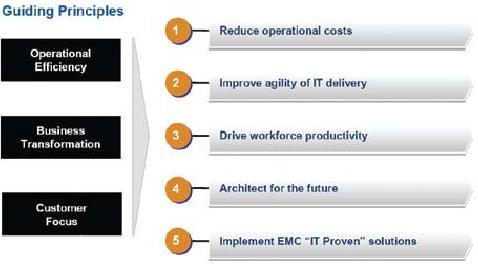
Journey to the Private Cloud starts now
As companies gear towards meeting its ever growing business requirements, its IT team has to embrace a next generation approach to its IT infrastructure.
The goal is to deliver an end-to-end, on-demand self-service provisioning of IT services to its business units. Thus IT organizations such as EMC’s IT Team decided to embark on a transformation to a private cloud-based IT infrastructure.
Principles and priorities
EMC IT’s vision is based on three principles: operational efficiency, business transformation, and customer focus. Making this vision a reality requires attention to the following priorities:
Reduce operational costs – Help business units lower the overall operations cost.
Improve agility of IT delivery – Increase flexibility of IT systems and processes to meet the changing needs of business units in the shortest possible time. Drive workforce productivity – Increase productivity through innovative applications, and invest in communication and collaboration technologies such as social computing and
telepresence. Architect for the future – Making IT investments toward architecting the desired future state and future proofing solutions for future requirements and changes.
Implement IT-proven solutions – Enabling the development of the highest-quality EMC products by serving as the live production testbed for EMC technology and driving customer orientation through use of the technology being developed.
Planning the transition to the cloud
EMC believes that to transform the IT organization, it has to address five perspectives:
• Technology
• Business capabilities and experience
• People
• Operations
• IT policies/process/governance
For organizations looking to adopt the private cloud strategy, EMC believes that there are three stages of adoption. They are as follows:
• The IT Production stage, which targets development/test/IT applications for virtualization to achieve cost efficiencies. Key capabilities leveraged include shared resource pools and elastic capacity”.
• The Business Production stage, which enables business applications including mission-critical applications with an emphasis on high QoS. Key capabilities leveraged include a zero-touch infrastructure and increased control with service assurance.
• The IT-as-a-Service stage, which emphasizes business agility. Key capabilities include service definition, service catalog, self-service, and chargeback.
Each stage is characterized by business drivers and triggers, level of sponsorship for virtualization, types of applications virtualized, percentage of the x86 server infrastructures virtualized, and the IT competencies acquired along the journey. When considering the stages of adoption, it is important to plan the transition in measured steps as follows.
Step 1: Build the foundation
This involves reaching out to technology practitioners in the IT organization to share information on basic cloud enabling technologies, including operations and integration methodologies.
Step 2: Accelerate change
This process consists of bringing discussions to the operations level with the delivery audience—people focused on delivering IT services to the business. These discussions should focus on the two agendas of IT operations personnel:
• Leveraging new technologies to better meet key performance indicators used to measure IT effectiveness
• Making organizational and process changes, to fully leverage the capabilities of the new technologies Changes in technology can provide only limited benefits unless accompanied by process and organizational change.
Step 3: Focus on the advantages of service management
Business units may not fully understand the advantages in migrating to a private cloudbased IT infrastructure. Discussions with business units must focus on the enhanced service management benefits that the new infrastructure offers, such as:
• Introducing new services that can drive value to business units
• Reducing the cycle time for businesses through self-service IT provisioning, choice of multiple providers, and service level agreement-based IT service delivery
• Providing customers, clients, and employees with better user experiences through optimized IT Infrastructures.
EMC IT recognizes that an important transformational initiative of this nature brings with it the need for organizational change as well as a change in behavior from its employees.
























 Advertise
Advertise










